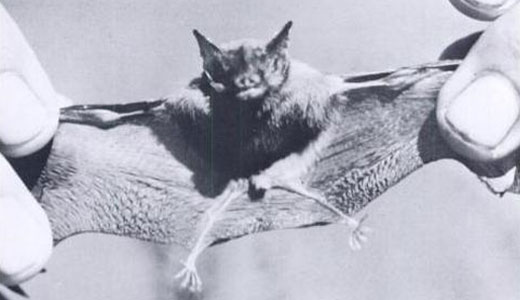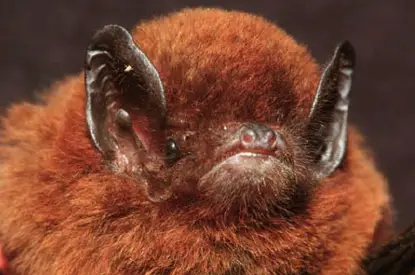Vampire Bat
Myths and legends from all over the world portray bats as blood-sucking demons. Vampire bats really do exist, but only three species in Central and South America.
The vampire bats (Desmodus rotundus) have a wingspan of about eight inches and a body about the size of an adult’s thumb. If not for their diet, people would not pay much attention to these small bats. Vampire bats feed on the blood of large birds, cattle, horses, and pigs. However, they donÕt suck the blood of their “victims”.
Using their sharp teeth, the bats make tiny cuts in the skin of a sleeping animal. The bats’ saliva contains a chemical that keeps the blood from clotting. The bats then lap up the blood that oozes from the wound. Another chemical in their saliva numbs the animal’s skin and keeps them from waking up.
A vampire bat finds its prey with echolocation, smell, and sound. They fly about one meter above the ground. Then they use special heat sensors in their noses to find veins that are close to the skin.
Scientists have discovered that vampire bat saliva is better at keeping blood from clotting than any known medicine. Vampire bats may one day help prevent heart attacks and strokes. Vampire bats are one of the few bat species that are considered a pest. In Latin America, cattle raising is a growing business, and sleeping cattle attract vampire bats. In ranching areas, control programs have been started. However, millions of beneficial bats are destroyed by people who mistake them for vampires.
Unlike fruit-eating bats, the vampire bats have a short, conical muzzle without a nose leaf. Instead they have naked pads with U-shaped grooves at the tip. The common vampire bat also has specialised infrared sensors on its nose (see [1]). A nucleus has been found in the brain of vampire bats that has a similar position and has similar histology to the infrared nucleus of infrared sensitive snakes.
They have small ears and a short tail membrane. Their front teeth are specialised for cutting and their back teeth are much smaller than in other bats. Their digestive systems are also specialised for their liquid diet. The saliva of vampire bats contains a substance, draculin, which prevents the victim’s blood from clotting. They, therefore, lap blood rather than suck it as most people imagine.
They come out to feed only when it is fully dark. Like fruit-eating bats, and unlike insectivorous and fish-eating bats, they only emit low-energy sound pulses. The Common Vampire Bat feeds mostly on the blood of mammals, whereas the Hairy-legged Vampire Bat, and the White-winged Vampire Bat feed on the blood of birds. Once the common vampire bat locates a host, usually a sleeping mammal, they land and approach it on the ground. A recent study found that common vampire bats can, in addition to walking, run at speeds of up to 1.2 meters per second. They possibly locate a suitable place to bite using their infrared sensors.
The feeding pattern of the vampire bat adds a layer of complexity to its anatomy. Because they often do not find host organisms for many hours and may have to fly a long distance to do so, vampire bats usually feed in enormous quantities. This influx of proteins may make the bat too heavy to fly. Accordingly, the bat’s urinary system accommodates this by releasing dilute urine consisting of a lot of water and fewer solutes. However, when the bat is resting, a new problem is faced. The large amounts of protein create excess urea and must be disposed of. The urinary system of the vampire bat then uses various hormones to make concentrated urine — consisting of more urea and less water. More..



Pretty much the only creepy bat I can think of… still, its cute… ;3